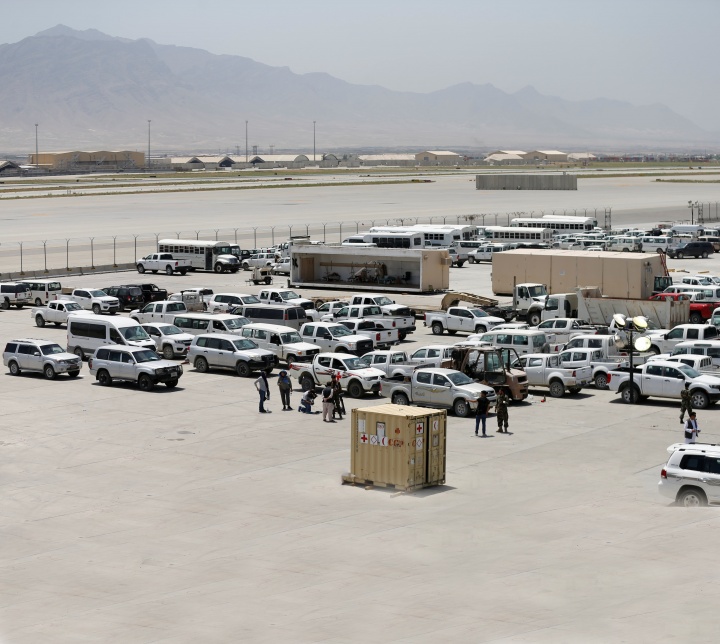America’s Uncertain Future
Downloads
America’s Uncertain Future

As this issue of Beyond Today was going to press, the last U.S. combat troops were being withdrawn from Afghanistan. Only a token force of several hundred will be left to guard the U.S. embassy compound in Kabul, the Afghan capital.
Perhaps nothing encapsulated the moment more poignantly than the U.S. withdrawal from the sprawling 30-square-mile Bagram Air Base, epicenter of America’s war against the Taliban and al-Qaeda for the last 20 years. The base was in reality a sizable city, built from the ground up on a large plain about an hour’s drive from Kabul.
It boasted American pizza and fast-food chain restaurants, air-conditioned fitness centers, a library, post office, a 50-bed hospital and a two-mile-long runway capable of handling dozens of U.S. fighter jets, reconnaissance aircraft and huge transport planes ferrying troops, weapons and supplies. At one time it was home for some 100,000 U.S. personnel.
In ironic timing, just before the July 4 Independence Day holiday, the last American occupants of the base shut off the electricity and slipped away into the night. Nearby looters arrived before Afghan soldiers and helped themselves to anything that wasn’t nailed down. Among items left behind were thousands of civilian trucks and vans and hundreds of armored vehicles, plus weapons and ammunition the Afghan soldiers would need to fight off the Taliban in battles sure to come.
Strategically, Bagram Air Base was a crucial military asset, located 500 miles from Iran and 400 miles from China, with runways that could handle any U.S. military aircraft of any size. But as is the case with so many critical American strategic assets in recent decades, it is no longer in U.S. hands—and will likely soon be in the hands of America’s enemies.
It’s the sad end of a 20-year saga that began with a highly coordinated terrorist assault on the United States on Sept. 11, 2001. In righteous indignation America, with a coalition of allies, went to war against terror-supporting governments in Afghanistan and Iraq.
But after 20 years, more than 60,000 U.S. casualties, and a fortune of almost $6.5 trillion in borrowed money squandered, American forces quietly withdrew, the nation no longer having the will to fight.
If you pay close attention to the news, you may have heard that America is said to now be facing more threatening and dangerous enemies. On June 9 U.S. President Joe Biden declared that global warming is “the greatest threat facing America.” Ironically, he said this as he arrived in Europe seeking support from allies against Russian hacking attacks that have devastated U.S. businesses and to combat Chinese secrecy over the origins of Covid-19, which has plagued the entire world.
Meanwhile, America’s true geopolitical opponents such as China, Russia, Iran and North Korea grow ever more dangerous. They’re not focused on teaching their military a rewritten “woke” version of their nations’ histories; they’re training their soldiers, sailors and pilots how to destroy and kill their enemies—with the United States at the top of the list.
The uncomfortable truth is, America has lost another war, and appears to not be any wiser. The last significant war America truly won was World War II, more than 75 years ago. In Korea the United States fought to a draw and agreed to a truce, leaving tens of thousands of troops there for two-thirds of a century now. Vietnam was an ugly defeat at the cost of nearly 60,000 American lives, and after the U.S. withdrawal communists in Vietnam and Cambodia murdered some 1.5 million of their own people. America and its allies did defeat Iraq in the first Gulf War after Iraq invaded Kuwait, but Saddam Hussein was left in power, leading to the second Iraq war and another slow, painful retreat for U.S. forces, to be completed by the end of this year. Folly reigns in the halls of power.
These wars collectively cost trillions of dollars and more than 100,000 American lives, and what do we have to show for it?
Our world is changing before our eyes, and in ways that are highly dangerous for the current world order and the United States in particular. You need to understand why. Be sure to read the articles in this issue, and continue to read Beyond Today magazine for understanding!
